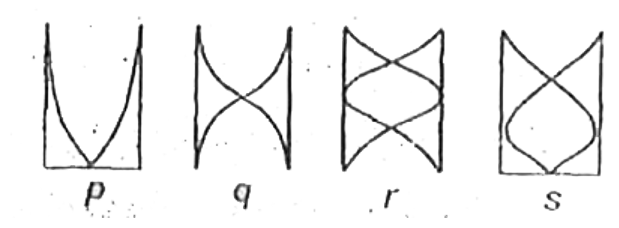The depletion region of a P-N diode, under open circuit condition contains
Electrons
Holes
Unmasked immobile impurity ions
Impurity atoms
The correct Answer is:C
To solve the question regarding the depletion region of a P-N diode under open circuit conditions, let's break it down step by step.
Step 1: Understand the Structure of a P-N Junction
A P-N junction diode consists of two regions: the P-type region, which has an abundance of holes (positive charge carriers), and the N-type region, which has an abundance of electrons (negative charge carriers).
Hint: Remember that P-type has holes and N-type has electrons.
Step 2: Identify Charge Carriers in Each Region
In the P-type region, the charge carriers are holes, which are created by doping the semiconductor with acceptor impurities. In the N-type region, the charge carriers are electrons, created by doping with donor impurities.
Hint: P-type = holes (positive), N-type = electrons (negative).
Step 3: Understand the Depletion Region
When the P-N junction is formed, electrons from the N-region diffuse into the P-region and recombine with holes. Similarly, holes from the P-region diffuse into the N-region and recombine with electrons. This recombination leads to the formation of a depletion region, which is devoid of free charge carriers.
Hint: Recombination of charge carriers leads to the depletion of mobile charges.
Step 4: Analyze the Composition of the Depletion Region
In the depletion region, only immobile ions remain. In the P-region, the immobile positive ions (from the acceptor atoms) are left behind after the holes have recombined. In the N-region, the immobile negative ions (from the donor atoms) remain after the electrons have recombined.
Hint: The depletion region contains immobile ions, not free charge carriers.
Step 5: Conclusion
Under open circuit conditions, the depletion region of a P-N diode contains unmasked immobile impurity ions. These ions are the result of the doping process that created the P-type and N-type materials.
Final Answer: The depletion region of a P-N diode under open circuit conditions contains unmasked immobile impurity ions.
A P-N junction diode consists of two regions: the P-type region, which has an abundance of holes (positive charge carriers), and the N-type region, which has an abundance of electrons (negative charge carriers).
In the P-type region, the charge carriers are holes, which are created by doping the semiconductor with acceptor impurities. In the N-type region, the charge carriers are electrons, created by doping with donor impurities.
When the P-N junction is formed, electrons from the N-region diffuse into the P-region and recombine with holes. Similarly, holes from the P-region diffuse into the N-region and recombine with electrons. This recombination leads to the formation of a depletion region, which is devoid of free charge carriers.
In the depletion region, only immobile ions remain. In the P-region, the immobile positive ions (from the acceptor atoms) are left behind after the holes have recombined. In the N-region, the immobile negative ions (from the donor atoms) remain after the electrons have recombined.
Under open circuit conditions, the depletion region of a P-N diode contains unmasked immobile impurity ions. These ions are the result of the doping process that created the P-type and N-type materials.
Topper's Solved these Questions
- SEMICONDUCTORSBOOK - RESONANCE ENGLISHCHAPTER - SEMICONDUCTORSEXERCISE - Exercise 2
16 Videos
- SEMICONDUCTORSBOOK - RESONANCE ENGLISHCHAPTER - SEMICONDUCTORSEXERCISE - Exercise 3
88 Videos
- SEMICONDUCTORSBOOK - RESONANCE ENGLISHCHAPTER - SEMICONDUCTORSEXERCISE - Exercise 3
88 Videos
- REVISION DPPBOOK - RESONANCE ENGLISHCHAPTER - REVISION DPPEXERCISE - All Questions
463 Videos
- SIMPLE HARMONIC MOTION BOOK - RESONANCE ENGLISHCHAPTER - SIMPLE HARMONIC MOTION EXERCISE - Advanced Level Problems
13 Videos
Similar Questions
Knowledge Check
In the depletion region of a diode.
AThere the mobile charges existBEqual number of holes and electrons exist. making the region neutral.CRecombination of holes and electrons has taken placeDNone of theseA potential barrier of 0.3 V exists across a p-n junction. If the depletion region is 1 μm wide, what is the intensity of electric field in this region?
A2×105Vm−1B3×105Vm−1C4×105Vm−1D5×105Vm−1A potential barrier of 0.50V exists across a P−N junction. If the depletion region is 5.0×10−7m, wide the intensity of the electric field in this region is
A106 V/mB107 V/mC105 V/mD104 V/m
The depletion layer in P−N junction region is caused by
View SolutionIn a p-n junction, depletion region contains
View SolutionWhat is meant by depletion region in a junction diode? How is this region formed?
View SolutionThe width of depletion region in p-n junction diode is 500nm and an intrinsic electric field of 6×105Vm−1 is also found to exist in it. What is the kinetic energy which a conduction electron must have in order to diffuse from the n-side to p-side?
View SolutionThe vibrations of four air columns under identical conditions are represented in the figure below. The ratio of frequencies np:nq:nr:ns will be

View Solution
